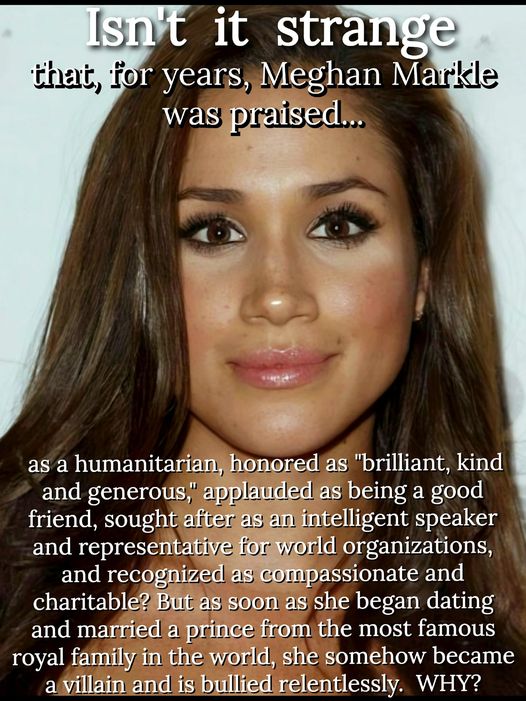This shift in public perception of Meghan Markle—from being celebrated for her humanitarian work to being seen as a controversial figure after marrying into the British royal family—raises important questions about societal expectations, media influence, and cultural biases. Here are some potential reasons behind this dramatic change:

1. Media Narratives and Sensationalism
The media plays a huge role in shaping public opinion, and Meghan’s story is no exception. Before she married Prince Harry, she was portrayed positively as an actress and humanitarian. However, her entrance into the royal family turned her into a focal point for British tabloids, which often favored sensationalism over accuracy. Headlines have frequently targeted her, sometimes exaggerating or taking her actions out of context to create compelling stories that draw readers. This relentless scrutiny can shape how the public perceives her, painting her in a negative light.
2. Breaking Traditional Norms
Meghan’s approach to royal life was different from the traditional expectations of a British royal family member. Her decision, along with Prince Harry, to step back from royal duties and chart a more independent path drew criticism from those who felt she wasn’t respecting royal customs or traditions. Meghan’s open discussions about her struggles and mental health were also seen by some as breaking the royal family’s usual preference for maintaining privacy and a stiff upper lip. For some, this divergence from tradition was seen as controversial and fueled negative perceptions.
3. Cultural and Racial Biases
It’s impossible to overlook the role of racial bias in how Meghan has been treated by both the media and segments of the public. As a biracial woman joining a predominantly white institution with centuries-old traditions, Meghan faced a unique level of scrutiny. Many commentators and observers have noted the racist undertones in some of the media coverage and public discourse surrounding her, particularly when compared to how other royal family members like Kate Middleton are treated. This bias may have contributed to the quick shift in how she was perceived.
4. Jealousy and Misplaced Expectations
Meghan’s sudden prominence on the world stage and her marriage to Prince Harry turned her into a polarizing figure, especially among those who follow the royal family closely. Some individuals may have held a romanticized view of what it means to be a royal, and Meghan’s decision to do things her own
5. Power Dynamics and Public Narrative
Meghan and Harr
6. Humanizing vs. Dehumanizing the Royal Image
Meghan has tried to be authentic and open about her
Conclusion: Why the Shift?
The change in how Meghan is perceived reflects a complicated blend of media dynamics, cultural expectations, and societal attitudes. The royal family is not just a family; it’s a symbol of British heritage and tradition, and anyone who challenges its norms can become a lightning rod for controversy. Meghan Markle’s story is a reflection of deeper societal tensions around race, class, tradition, and the power of the media, revealing how quickly public opinion can shift und
In the end, the question of why Meghan went from being seen as a humanitarian hero to a villain isn’t about any one action or decision she made—it’s about how society reacts to change, difference, and challenges to lo
